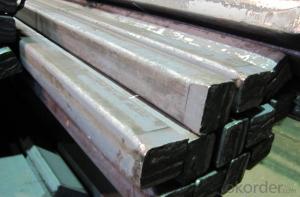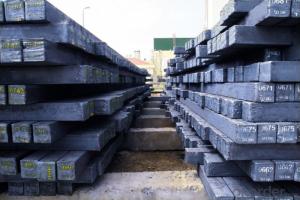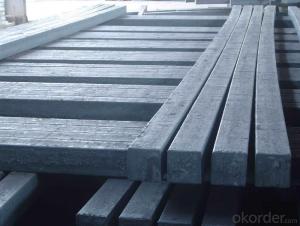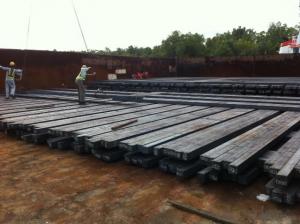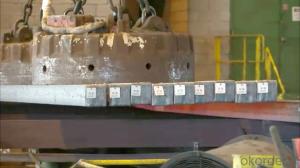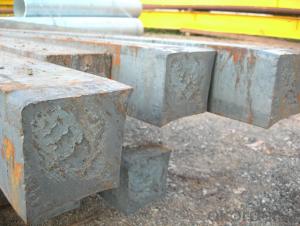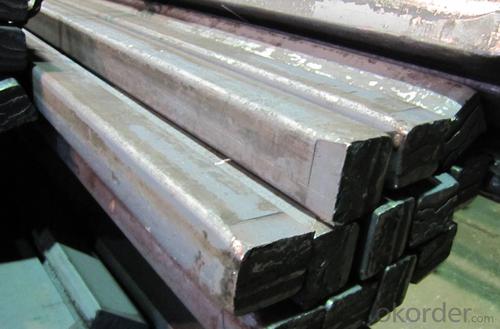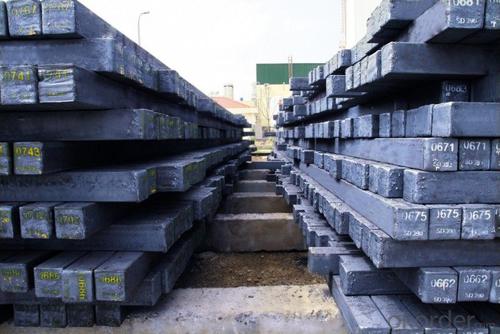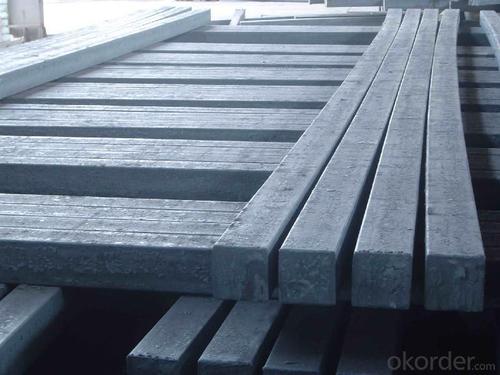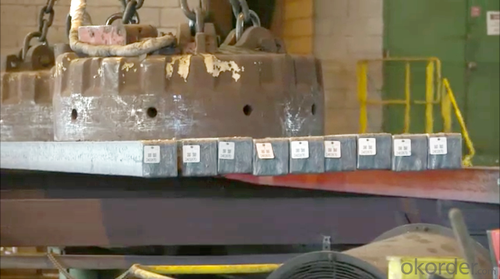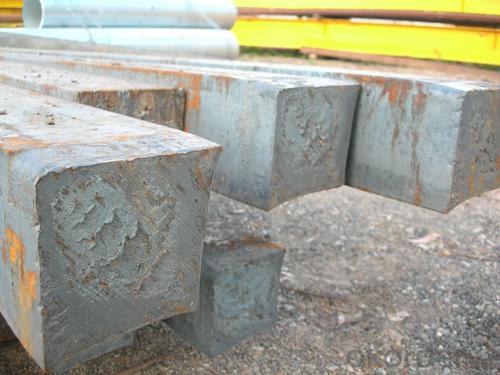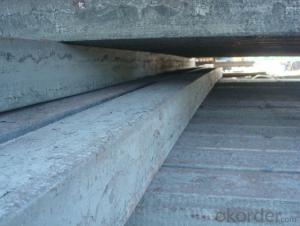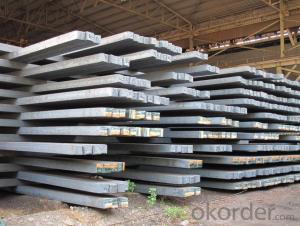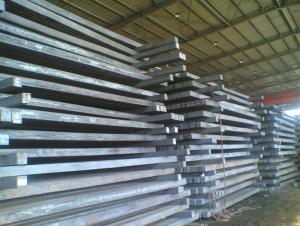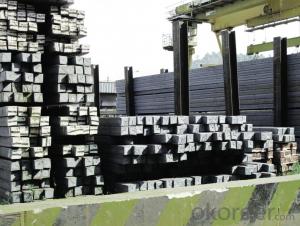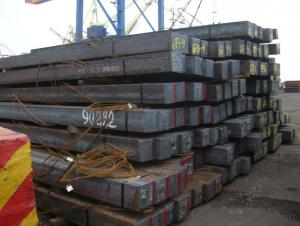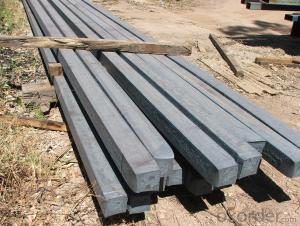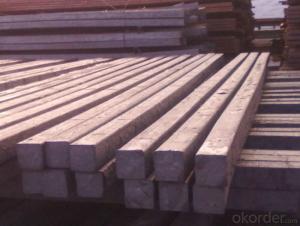Hot Rolled Steel Billet 3SP Standard 180mm
- Loading Port:
- Shanghai
- Payment Terms:
- TT OR LC
- Min Order Qty:
- 100 m.t.
- Supply Capability:
- 10000 m.t./month
OKorder Service Pledge
OKorder Financial Service
You Might Also Like
Structure of Hot Rolled Steel Billet 3SP Standard 180mm

Description of Hot Rolled Steel Billet 3SP Standard 180mm
Prepainted Rolled steel Coil is a kind of coated steel coil/sheet. With the cold rolled steel of different strength and thickness as substrate, it is produced through applying Al-Zn coat on both faces by hot dip process. In its coating, Al accounts for about 55%, Si 1.6%, while the remaining is Zn. Aluminum zinc coils enjoys both the physical protective feature and durability of Al and the electrochemical protective property of Zn. And its surface has bright silver color and regular embossed-like figure, which are highly decorative. RAL Scale Z35 Prepainted Rolled Steel Coil for Construction Roofing

Main Feature of Hot Rolled Steel Billet 3SP Standard 180mm
1.Corrosion resistance: It mainly depends on the zinc protection. When the zinc being worn,
2. Heat resistance: steel sheet has excellent heat resistance, can withstand high temperatures over 300 centigrade, and is similar with aluminized steel high temperature oxidation resistance. It often used in chimney pipes, ovens, fluorescent lighting device and the device cover.
3. Heat reflective: Galvanized steel plate heat-reflective high rate is twice as galvanized steel, often used to make insulation materials. RAL Scale Z35 Prepainted Rolled Steel Coil for Construction Roofing
Applications of Hot Rolled Steel Billet 3SP Standard 180mm
1. Construction and building: roofing; ventilating duct; handrail; partition panel;etc.
2. Electric appliance: refrigerator; washing machine; refrigerator; DVD;etc.
3.Transportation: oil tank; gas tank;road sign; etc.
4.Agriculture constructions :barn; etc.RAL Scale Z35 Prepainted Rolled Steel Coil for Construction Roofing
5.Others:vending machine; game machine; auto parts spare parts etc.
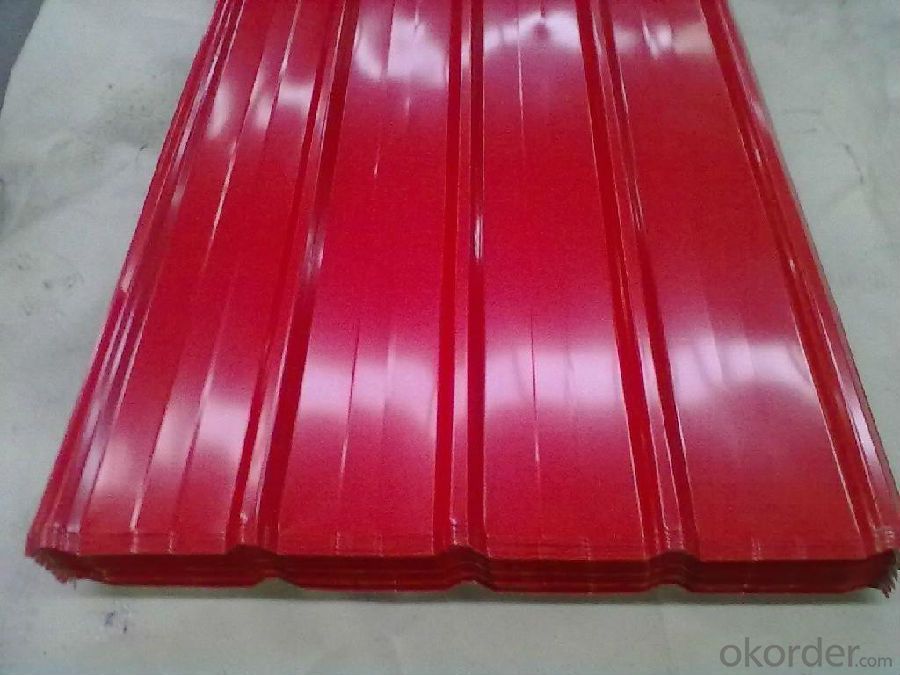
Specifications of Hot Rolled Steel Billet 3SP Standard 180mm
Product | Hot Rolled Steel Billet 3SP Standard 115mm |
Material Grade | SGCC / SGCH / DX51D+AZ, etc |
Thickness | 0.5-3.0mm |
Width | 700-1500mm |
Tolerance | Thickness: +/-0.02mm , Width:+/-2mm |
Zinc-coating | AZ30-150g/m2 |
Technique | Raw material: Hot rolled steel coil --> Cold rolled_>hot dipped galvalume |
Surface | Dried, Chromated, Unoiled,RAL Scale Z35 Prepainted Rolled Steel Coil for Construction Roofing |
Spangle | Regular spangle , small spangle, zero spangle |
ID | 508MM 610MM |
Coil weight | 25MT max |
Export package | Cardboard inner sleeves, Waterproof paper, galvanized steel covered and steel strip packed |
FAQ of Hot Rolled Steel Billet 3SP Standard 180mm
We have organized several common questions for our clients,may help you sincerely:
1. What is the minimum order quantity ?
Our MOQ is 100 mt for each size each specification. Usually we can offer discount if can buy large QTY once. RAL Scale Z35 Prepainted Rolled Steel Coil for Construction Roofing
2. How long can we receive the product after ordering?
Our general delivery time is 30 days after confirmation, but so some special orders, we have offer special delivery time
3. How to guarantee the quality of the products?
We have established the international advanced quality management system ,every link from raw material to final product we have strict quality test;We resolutely put an end to unqualified products flowing into the market. At the same time, we will provide necessary follow-up service assurance.
4. What is the payment?
We accept T/T, L/C
- Q: Can steel billets be used in the production of appliances?
- Yes, steel billets can be used in the production of appliances. Steel billets are semi-finished products that are typically used for further processing into various shapes and sizes. In the case of appliances, steel billets can be used as the raw material for manufacturing components such as frames, panels, and other structural parts. Steel is a versatile and durable material that offers strength, stability, and resistance to corrosion, making it suitable for use in appliances that require robust construction. Additionally, steel can be easily molded and shaped to meet the specific design requirements of different appliances, making it a preferred choice in the manufacturing process.
- Q: What are the specifications for stainless steel billets used in the food industry?
- Stainless steel billets used in the food industry have specific specifications to ensure safety and hygiene. These specifications primarily focus on the composition of the stainless steel, its corrosion resistance, and its ability to withstand high temperatures and aggressive cleaning agents. Firstly, the stainless steel used for food industry billets must have a high chromium content, typically ranging from 16% to 18%. This chromium content provides excellent corrosion resistance, preventing the material from reacting with food or cleaning agents. Additionally, these billets should have a low carbon content, usually below 0.08%. Low carbon stainless steel is less prone to sensitization, a process that can lead to corrosion and contamination of food products. Moreover, the stainless steel billets must comply with specific international standards, such as the ASTM A276 or EN 10088, which outline the minimum requirements for chemical composition, mechanical properties, and surface finish. Furthermore, the surface finish of the billets is crucial in the food industry. It must be smooth and free from any defects, such as pits or cracks, to prevent the accumulation of bacteria and facilitate easy cleaning. The dimensions of the billets also play a role in their suitability for the food industry. They are commonly available in square or rectangular shapes, with various sizes depending on the specific application. Lastly, these billets should be certified and compliant with industry regulations, such as those set by the Food and Drug Administration (FDA) or the European Food Safety Authority (EFSA). In summary, stainless steel billets used in the food industry must have a high chromium content, low carbon content, and comply with international standards. They should also possess a smooth surface finish, appropriate dimensions, and meet industry regulations for safety and hygiene.
- Q: What are the different methods of shaping steel billets?
- There are several different methods of shaping steel billets, each with its own advantages and applications. Some of the common methods include forging, rolling, extrusion, and casting. 1. Forging: Forging is a process in which the steel billet is shaped by applying pressure through the use of hammers or presses. This method allows for precise shaping and can produce complex shapes with high strength and durability. Forging is commonly used in manufacturing components for automotive, aerospace, and construction industries. 2. Rolling: Rolling is a process that involves passing the steel billet through a series of rollers to reduce its thickness and shape it into various forms such as sheets, plates, or bars. This method is highly efficient and can produce large quantities of steel products with consistent dimensions and surface finish. Rolling is commonly used in the production of structural steel, pipes, and tubes. 3. Extrusion: Extrusion is a process in which the steel billet is forced through a die to create a desired shape. This method is particularly suitable for producing long and continuous profiles with complex cross-sections, such as rods, tubes, and wire. Extrusion allows for precise control over the shape and dimensions of the final product and is commonly used in the manufacturing of aluminum window frames, automotive parts, and electrical conductors. 4. Casting: Casting is a method in which molten steel is poured into a mold and allowed to solidify into the desired shape. This process is versatile and can produce intricate and large-scale components with minimal material waste. Casting is commonly used in the production of steel ingots, pipes, and large structural components. These methods of shaping steel billets offer different advantages in terms of efficiency, precision, and versatility. The choice of method depends on the specific requirements of the desired steel product, including size, shape, strength, and cost-effectiveness.
- Q: How do steel billets contribute to the manufacturing of aerospace components?
- The manufacturing of aerospace components heavily relies on steel billets, which are semi-finished products utilized as the initial material in creating various aerospace parts. The versatility of steel billets contributes significantly to the manufacturing of aerospace components. Steel possesses exceptional strength, durability, and corrosion resistance, making it an ideal material for aerospace applications. High-quality steel billets form a solid foundation for producing components that can withstand the extreme conditions encountered during aerospace operations. Steel billets find extensive use in manufacturing critical aerospace parts such as engine components, landing gear, structural frames, and fasteners. The billets undergo heating and are then subjected to various forming and machining processes. These processes, including forging, rolling, and extrusion, shape the steel billets into the desired components, ensuring they meet the aerospace industry's stringent requirements for strength, precision, and weight reduction. Additionally, steel billets offer remarkable design flexibility. They can be easily machined and shaped into intricate geometries, enabling manufacturers to create aerospace components with precise tolerances. This flexibility allows the production of lightweight yet sturdy parts, contributing to aircraft weight reduction and enhancing fuel efficiency. Moreover, steel billets possess superior metallurgical properties. By employing appropriate heat treatment and alloying techniques, the mechanical properties of the steel can be customized to meet specific aerospace requirements. This enables manufacturers to achieve the desired balance between strength, stiffness, and toughness in the final components, ensuring their ability to withstand the high-stress environments encountered in aerospace applications. In conclusion, steel billets play an indispensable role in the manufacturing process for aerospace components. Their versatility, strength, design flexibility, and metallurgical properties make them an excellent starting material for producing critical parts in the aerospace industry. Utilizing steel billets allows manufacturers to ensure the production of high-quality, reliable, and long-lasting components that meet the rigorous demands of the aerospace sector.
- Q: Billet prices skyrocketing weekend, Southern China steel prices rose?
- In December 5th, the billet price in Hebei was 2780 yuan per ton, a new high since two years and three months, a rise of more than 85% over the same period of last year.
- Q: What is the weight of a standard steel billet?
- The weight of a standard steel billet can vary depending on its dimensions, but typically ranges from 1 to 6 metric tons.
- Q: How are steel billets used in the manufacturing of gears and bearings?
- Steel billets are used in the manufacturing of gears and bearings as they serve as the raw material for forging or casting processes. These billets are heated and shaped into the desired form, such as gear blanks or bearing races, using specialized machinery. The high strength and durability of steel make it an ideal material choice for these applications, ensuring the gears and bearings can withstand heavy loads and provide smooth operation.
- Q: What are the common surface defects in steel billets during reheating?
- Several surface defects may occur during the reheating process of steel billets, which can negatively impact the quality and integrity of the final product. Some of the most common surface defects observed in steel billets during reheating are as follows: 1. Scale Formation: When steel billets are subjected to high temperatures, a layer of iron oxide, referred to as scale, can develop on the surface. Scale is brittle and can easily crack or flake off, resulting in a rough and uneven surface. 2. Decarburization: Exposing steel billets to high temperatures causes the loss of carbon from the surface, known as decarburization. This leads to a decrease in carbon content on the surface, making it susceptible to cracking, reduced hardness, and poor mechanical properties. 3. Surface Oxidation: During reheating, steel billets can undergo oxidation when exposed to oxygen in the air. This results in the formation of a thin layer of oxide on the surface, affecting the surface finish and potentially reducing the steel's corrosion resistance. 4. Overheating: If the reheating process causes localized melting or partial melting of the steel billets, it is referred to as overheating. This can lead to surface irregularities, such as pits, cracks, or blisters, compromising the integrity of the billets. 5. Hot Spots: Uneven heating of the steel billets can cause hot spots to form on the surface. These localized areas of excessive heat can result in surface defects like warping, cracking, scorching, or discoloration. 6. Surface Contamination: During reheating, steel billets may come into contact with contaminants such as dirt, oil, or other foreign materials. These contaminants can adhere to the surface, leading to surface defects like stains, pitting, or an uneven surface finish. 7. Thermal Shock: Rapid temperature changes during reheating can cause thermal shock, resulting in surface defects like cracks or distortions. This can occur when the steel billets are exposed to water or a cooling medium, or when there are significant temperature differences across the surface. To minimize these surface defects in steel billets during reheating, it is essential to employ proper heating techniques, control heating rates, and use protective coatings or atmospheres. Additionally, regular inspection and quality control measures can help identify and mitigate surface defects before they impact the final product's quality.
- Q: What are the international standards or certifications for steel billets?
- Steel billets are subject to various international standards and certifications, which guarantee their quality, safety, and compliance with industry regulations. One widely recognized standard is the ISO 9001 certification, which establishes criteria for a quality management system. This certification ensures that steel billet production adheres to international quality standards and consistently meets customer requirements. In addition to ISO 9001, the steel industry has other specific certifications. The ISO 14001 certification focuses on environmental management systems, ensuring that steel billet production follows sustainable practices. This certification demonstrates a commitment to minimizing environmental impact and promoting sustainable development. Another crucial certification is the ISO 45001, which emphasizes occupational health and safety management. This certification verifies that steel billet manufacturers have implemented effective safety protocols and procedures to protect employees and prevent workplace accidents. Moreover, the American Society for Testing and Materials (ASTM) establishes standards for steel billets, such as ASTM A615/A615M for deformed and plain carbon-steel bars used in concrete reinforcement. These standards outline mechanical properties, chemical composition, and testing methods for steel billets used in construction applications. Similarly, the European Committee for Standardization (CEN) sets standards for steel billets through the European Norm (EN) system. For example, EN 10025 specifies technical delivery conditions for structural steel products, including steel billets, used in various European industries. Adhering to these international standards and certifications is crucial for steel billet manufacturers. It ensures the quality, safety, and compliance of their products. Conforming to these standards not only enhances the manufacturer's credibility and reputation but also provides customers with confidence that the steel billets they purchase meet the highest industry standards.
- Q: What are the different surface finishes available for steel billets?
- There are several surface finishes available for steel billets, including mill finish, hot rolled pickled and oiled (HRPO), cold rolled, galvanized, and coated finishes. These finishes enhance the appearance, protect against corrosion, improve surface smoothness, and provide specific properties required for different applications.
Send your message to us
Hot Rolled Steel Billet 3SP Standard 180mm
- Loading Port:
- Shanghai
- Payment Terms:
- TT OR LC
- Min Order Qty:
- 100 m.t.
- Supply Capability:
- 10000 m.t./month
OKorder Service Pledge
OKorder Financial Service
Similar products
Hot products
Hot Searches
Related keywords
